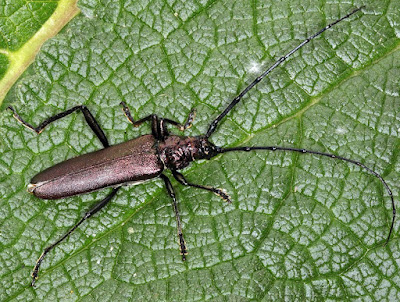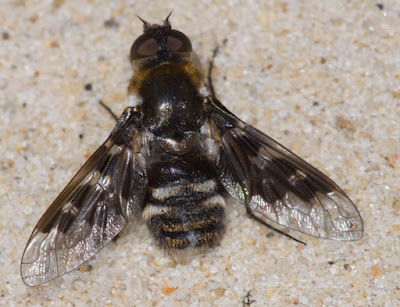As I sat at my computer late on Monday night, I decided to check my e-mails one last time before bed. An e-mail from LGR Evans entitled "Oriental Turtle Dove Refound in Oxfordshire" set my heart beating a bit faster. This bird had been seen in a garden in Chipping Norton in December but was then lost to science for a bit. The news seemed to be that a birder in Chipping Norton had refound it feeding on his lawn. Sheesh and I thought my Brambling record this winter had been great up until then. He was prepared to let people into his kitchen to watch the bird as long as they followed the rules: no shoes in the house, no more than ten at a time, no more than ten minutes per group, a five pounds donation to Birdlife International per person, viewing only between 10 am and 4 pm. These rules all seemed fair so I then considered the weather forecast. Hmmmm not too good there, with rain expected early morning and continuing most of the day. I then checked out the street the house was on using Google maps. Those residents were sure in for a shock when daylight broke. The next question was when to arrive on site. I opted for the old maxim "if you have to queue make sure you are first in line" so gathered together my binoculars and several layers of warm clothing.
I then went upstairs to gently wake my wife and tell her I would be doing without sleep for a bit. She has a lot of practice of living with a birder so didn't turn a hair. By 0200 I was on the road and by 0515 was in Chipping Norton free long-stay car park, eating the sandwiches I had bought on the way there. Always a good idea to carb load early as you never know how the day will pan out or if you will get to a food outlet later on. I then stood in the dark for a bit listening to the dawn chorus and marvelling at the number of people who turned up in their cars at that time and wandered off to bed I presume. At about 0630 the second birder showed up and by 0700 I set off to find the house and see if the bird was visible in the neighbourhood. I was the second birder at the house and over the next hour we were joined by about fifty others who formed a loose queue and scanned every passing Collared Dove in case it was not one.
Just before 0830, the owner of the house saw the bird on his back lawn and decided to let people in earlier than advertised. So it was shoes off, pay your fiver and wander through to the kitchen. By the time we got inside the bird had flown to a tree and we watched it through binoculars that kept fogging up because of the warmth inside after the cold outside. Our group all got onto the bird and had acceptable views of it. It suddenly turned on its branch and flew slightly left, landing again then shortly afterwards flew onto the garden fence and dropped into the garden next-door. We dutifully trooped back outside to let the second group in, warning everyone to keep their binoculars inside their coats to keep them warm. We needn't have bothered because the bird wasn't seen again all day. By the time i left at lunchtime the rain had started in earnest and I didn't hold out much hope for those at the back of the now lengthy queue of around 400-500 that wound up the street even if the bird reappeared in the garden. I just thanked my lucky stars for my decision to get there early.
Wednesday, 16 February 2011
Great Grey Day - January 2011
I finally caught up with the Great Grey Shrike that has been around at Shapwick National Nature Reserve since last year. It took some finding but eventually I stumbled across it and managed to get a couple of shots before it zoomed off into the distance.
A Walk on the Wild Side - January 2011
We went to Dartmoor for a walk to try to get rid of the post Christmas weight gain. To be fair, I didn't partake of the walking too much, spending my time taking photographs from a safe distance :-)
I have also been practising with images to produce HDR (high dynamic range) images. This process uses clever software to take the highlights and shadow detail from three images of the same view that have been given different exposures and then combines the best bits of all three into one image. It takes a bit of fiddling to get it looking decent and it usually has a sort of fantasy world look to it but some images do become much more dynamic as a result.
I have also been practising with images to produce HDR (high dynamic range) images. This process uses clever software to take the highlights and shadow detail from three images of the same view that have been given different exposures and then combines the best bits of all three into one image. It takes a bit of fiddling to get it looking decent and it usually has a sort of fantasy world look to it but some images do become much more dynamic as a result.
Waxwings at Last - December 2010
After many weeks of hoping, I finally got my wish and connected with one of the many flocks of Waxwing that have visited our shores during November and December.
BRRRRRRR!!! - December 2010
We had a really long spell of cold weather this December. The birds got through more sunflower hearts than I would have thought possible and it was positively grey and frozen on most days. There were some nice things about it though, hoar frost being one of them and the opportunities for some novel photographs.
Dipper City - November 2010
Some friends came to visit us from Norfolk and on one of the days we decided to go to Exmoor. Coming from Norfolk they never get to see many hills so it seemed a good plan. We eventually reached Lynmouth and walked up the river where the great flood in the fifties had destroyed most of the town. On the day we were there it was a much quieter scene and we were soon on the hunt for a good photograph of a Dipper. These amazing birds spend all their time along fast flowing rivers and streams, a lot of the time walking under the water to find food that hides under the pebbles on the bed of the stream. After some careful stalking we managed to get some very nice shots.
Dawlish Tug-O-War
On a walk along Dawlish Warren, our attention was grabbed by a furious growling and splashing down at the tideline. On investigating we were amazed to find a full scale tug-o-war competition going on between a Great Black-backed Gull and a Cormorant over a fair-sized Flounder. It looked as though the Cormorant had caught it near the shore and as it was a fair size, it had been trying to swallow it. The gull, seeing an opportunity for a quick meal grabbed the tail and while we stood and gaped at the sight, it dragged both the fish and the protesting Cormorant out of the water. Eventually the Cormorant relinquished its grasp on the Flounder and went off to sulk, leaving the gull to eat his stolen meal.
Pits Plants and Purple Sands - October 2010
Chris and I made a short trip to the north east and visited Alnwick to see the recently created gardens there. We also spent some time on the magnificent coastline of Northumberland, ate Craster kippers and watched some of the great wildlife up there. The gardens at Alnwick are very interesting with a magnificent water feature that would give Charlie Dimmock a run for her money and a special "poison" garden.
The old pithead at Hilda Colliery where several of my ancestors worked as miners.
The north east in winter is a great place to view Purple Sandpipers as they feed right at the edge of the water on the wave-splashed rocks.
The old pithead at Hilda Colliery where several of my ancestors worked as miners.
The north east in winter is a great place to view Purple Sandpipers as they feed right at the edge of the water on the wave-splashed rocks.
The Return of the Crane - October 2010
Since July 2010 I have been involved in a project to return the Crane to its old haunts of the Somerset Levels. Cranes bred in Norfolk in the 1980s for the first time since the 1600s and now have a small population that is growing. The Great Crane Project aims to create another viable breeding population in the south west. Over the next five years, about twenty-five cranes per year will be set free on the levels to build a self-sustaining group. This year's release group are now free-flying and make a thrilling sight as they move over the flat landscape.
South Hams - September 2010
Chris and I spent a delightful time in the South Hams this September, visiting local National Trust properties and seeing some amazing wildlife. Highlights were the house and gardens at Coleton Fishacre and the home of Agatha Christie, perched above the stunning Dart Valley. We saw some amazing birds, including Glossy Ibis and Cirl Bunting.
Welcome Newcomers - August 2010
The eastern counties of England are seeing a rush of new species of dragonfly and damselfly that are colonising or recolonising our shores from Europe. After the first few appeared only a couple of years ago, the Willow Emerald damselfly is increasing in numbers and can now be found in several south eastern counties.
Musk Beetle Drop-In - August 2010
While doing volunteer work at Shapwick National Nature Reserve, I was suddenly forced to stop the reed cutting machine that I was operating when I noticed that the last bunch of reeds and other waterside vegetation that I had mown through had a large struggling insect trapped in their stems. I was overjoyed on uncovering it to see it was the large longhorn beetle, Aromia moschata. This insect lays its eggs on the branches of Sallow bushes and the larvae burrow inside the branch to grow. The adults often visit flowering plants and this was obviously what this beast had been doing before its lunch was so rudely interrupted. After photography and parading before the rest of the group and several amazed passing visitors, the beetle was released back to the relative calm of the reedbed.
Beetling off to Dungeness - August 2010
Each year, the nations Coleopterists have a meeting somewhere to do a mass recording of a certain area. This looks for new species and confirms the continued existence of important species. This year, the shingle ridges of Dungeness were the chosen venue. Several species of beetle were being sought out, many of them were specialist sand and shingle dwellers and as this habitat changes over time it is important to monitor it regularly to see if the species are still present. Fortunately, the main species being looked for, Omophron limbatum, was eventually found to be still present. It lives in burrows in areas of quicksands on the edge of sand and gravel workings and is at risk from vegetation stabilising the sands and drying them out.
The weekend went quickly with many trips to different areas of the Dungeness peninsula both during daylight hours and after dark. Two other exciting finds were the tenebrionid beetle, Helops caeruleus, which was discovered on railway sleepers in the shingle and a tiny dung beetle, Psammodius asper, that made its home next to the many rabbit burrows in the more sandy areas.
The weekend went quickly with many trips to different areas of the Dungeness peninsula both during daylight hours and after dark. Two other exciting finds were the tenebrionid beetle, Helops caeruleus, which was discovered on railway sleepers in the shingle and a tiny dung beetle, Psammodius asper, that made its home next to the many rabbit burrows in the more sandy areas.
The Greater of All Weevils - July 2010
James McGill discovered some larvae in the rootstock of Purple Loosestrife plants that turned out to be the Weevil - Hylobius transversovittatus. This species used to be fairly common in Somerset when peat extraction was at its peak and Purple Loosestrife grew in profusion on the disturbed ground. Since peat digging has declined and the plant has similarly declined in abundance so the weevil became even more rare and hadn't been seen for years. As Somerset is the only area in the UK for this weevil, James was understandably excited. The adults are nocturnal, so armed with headtorches and in slight trepidation at our imminent arrest, we wandered along a remote drove out on the levels just before midnight. James discovered the first adult and after a while we both had discovered them. Since that first discovery, James has seen the signs of larval damage at a few more sites, so this wonderful beast is still hanging on in Somerset.


Studland Heath - June 2010
Scarce Visitor to Shapwick - May 2010
At the end of May, while doing some survey work for the Avalon 24 bioblitz, I managed to photograph a new dragonfly for the reserve found by one of the visiting recorders. Scarce Chaser - Libellula fulva is a very local species in the south west but seems to be on the increase. Hopefully, this male found a female and we will see lots more of these along the South Drain in coming years.


Square Bashing - May 2010
The Queen's Back Garden - May 2010
James McGill and I joined a field meeting of the Dipterist's Group that were visiting an area of Windsor Great Park not usually open to the general public. This area is very good for a variety of species that have died out in the surrounding countryside. Apart from a good number of nice beetles that were not very photogenic, we managed to see some very nice colourful click beetles and a "holy grail" species of hoverfly that had many of the dipterists drooling.




A Jewel in the Sand - April 2010
In April 2010 I visited Berrow Dunes to look for various beetles that live along the tideline under rocks and pieces of driftwood. One of the specialities of the area that had not been seen for several years was Dune Tiger Beetle - Cicindella maritima. I was, therefore, very happy when I saw one of these amazingly colourful beetles scuttling across the bare sand. Unfortunately, the dunes area is rapidly becoming overgrown with the invasive shrub Sea Buckthorn so how long this beetle will hang on without the large areas of open dunes that it prefers is a matter for concern.


Surprise Visitor - March 2010
While driving home from Shapwick National Nature Reserve one evening we came across an amazing sight in a field near High Ham village. one of the Bustards from the Salisbury Plain reintroduction project had taken up residence with a flock of local Mute Swans and fed unconcerned just a few metres from the road.


Mad March Hares - March 2010
In late March 2010, Chris and I took a trip up to the north east to see my parents. On the way back we called in to see Lincoln Cathedral and then stayed for a few days with friends in Norfolk. One of the highlights of the Norfolk visit was photographing hares as they did their amazing chases and boxing matches in the fields near Strumpshaw RSPB reserve.

The mornings started early to get the car/hide into position before the hares started to perform.

Soon the chase was on.

The action was quite confusing at times.

At other times it was really spectacular. All in all a fantastic few hours of nature in action, all for free.

The mornings started early to get the car/hide into position before the hares started to perform.

Soon the chase was on.

The action was quite confusing at times.

At other times it was really spectacular. All in all a fantastic few hours of nature in action, all for free.
How time flies.
Just realised that it has been over a year since I posted anything on here. That's not to say I've had nothing to write about, just that it has been so full of things to get engrossed in that actually writing them up has been the last thing on my mind. Chris and I started a veg plot in April 2010 and it has been very successful. It is on the one acre plot of some people in the next village who wanted to do something with their grassy plot and responded to a message I put in the Parish News asking for people interested in allotments to get in touch.






Subscribe to:
Comments (Atom)





























